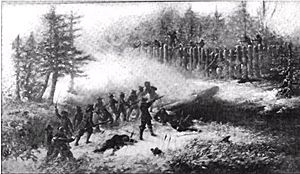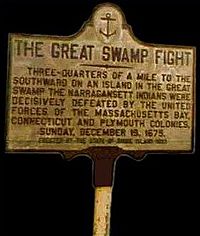Great Swamp Fight facts for kids
Quick facts for kids Great Swamp Massacre |
|||||||
|---|---|---|---|---|---|---|---|
| Part of King Philip's War | |||||||
 A painting of the Great Swamp Fight |
|||||||
|
|||||||
| Belligerents | |||||||
| New England Confederation Pequots Mohegans |
Narragansetts | ||||||
| Commanders and leaders | |||||||
| Governor Josiah Winslow (Commander-in-chief) Major Samuel Appleton (Massachusetts Bay Colony commander) Governor Robert Treat (Connecticut Colony commander) Major William Bradford (Plymouth Colony commander) Uncas (Mohegan Sachem) Captain William Raymond |
Canonchet (Narragansett Sachem) | ||||||
| Strength | |||||||
| 1,000 militia 150 warriors |
1,000 warriors 1 fort |
||||||
| Casualties and losses | |||||||
| ~70 killed ~150 wounded |
~ 97 warriors killed ~300-1,000 non-combatants killed ~300 captured 1 fort destroyed |
||||||
The Great Swamp Fight was a major battle during King Philip's War. It happened in December 1675. This fight was between the colonial militia from New England and the Narragansett people. It took place near the towns of Kingston and West Kingston in the Colony of Rhode Island and Providence Plantations.
The colonial forces included about 150 Pequots and Mohegan warriors. They caused many Narragansett casualties. This included many women and children. People have called it "one of the most brutal and lopsided military encounters in all of New England's history." Since the 1930s, Narragansett and Wampanoag people remember this battle every year. They hold a special ceremony started by scholar Princess Red Wing.
Contents
Why the Fight Happened
The Pokanoket Indians, led by Massasoit, had helped the first Pilgrim settlers survive. After Massasoit died, his sons Wamsutta and Metacom became leaders. Metacom was also known by his English name, Philip. He became the sachem (chief) in 1662.
Philip started planning attacks against the colonists. These attacks were in Massachusetts, Rhode Island, and Connecticut. He slowly brought together other Native American tribes. He also gathered weapons and gunpowder. He did this in small amounts so the colonists would not notice.
King Philip's War began on June 20, 1675. Several Wampanoag men attacked and killed colonists in Swansea, Massachusetts. The Native Americans then surrounded the town. Five days later, they destroyed it and killed more people. A full eclipse of the moon happened on June 27, 1675. Many tribes saw this as a good sign for attacking the colonists.
Officials from the Plymouth and Massachusetts Bay colonies quickly responded. On June 28, they sent soldiers. These soldiers destroyed the Wampanoag town at Mount Hope.
Native American groups attacked settlements in Massachusetts and Connecticut. Rhode Island was safe at first. In October, attacks happened again in Hatfield, Northampton, and Springfield. Almost all of Springfield was burned down. As winter arrived, the attacks slowed down.
The Narragansetts officially stayed neutral in the war. Roger Williams had encouraged them to do so. They signed a peace treaty with the Massachusetts Bay Colony in October 1675. However, they had given shelter to many of King Philip's people. Some of their warriors had also joined in raids.
The colonists did not trust the Narragansetts. They worried the tribe would join King Philip in the spring. This was a big concern because of where the Narragansetts lived. The militia burned several empty Narragansett villages. This happened as they marched around Narragansett Bay. The tribe had moved to a large fort in the Great Swamp.
On November 2, 1675, Josiah Winslow led a large force. It had over 1,000 colonial militia members. It also included about 150 Pequots and Mohegan warriors. They marched against the Narragansetts.
One colonist named Joshua Tefft was accused of fighting with the Native Americans. He reportedly hurt Captain Nathaniel Seely of Connecticut. Seely later died. An Indian spy said Tefft "did them good service." He also said Tefft had killed an English miller before the fight.
The Battle Begins
On December 15, 1675, peace talks failed. Stonewall John and other Narragansett warriors attacked the Jireh Bull Blockhouse. They killed at least 15 people. A 15-year-old boy named James Eldred escaped. He survived a close call with a tomahawk and a hand-to-hand fight. This happened near Indian Run Brook in Wakefield-Peacedale, Rhode Island. The Narragansetts saw swamps as good places to defend themselves. This is why they stayed in the Great Swamp during the war.
Four days later, the Great Swamp Battle took place. It was a very cold and stormy day, December 19, 1675. An Indian guide named Indian Peter led the colonial militia. The militia was from Plymouth Colony, Connecticut Colony, and Massachusetts Bay Colony. They went to the main Narragansett settlement in South Kingstown, Rhode Island.
The very cold temperatures froze the water around the Narragansett fort. This made it easy for the colonial troops to cross. The large fort covered about 5 acres of land. It was home to over a thousand people. After a fierce fight, the fort was taken over. The settlement was burned. Its people, including women and children, were killed or forced out. Most of the tribe's winter food was destroyed.
It is believed that at least 97 Narragansett warriors were killed. Between 300 and 1,000 non-fighters also died. About 300 people were captured. The colonial forces destroyed the blacksmith shop of Stonewall John. He escaped but was killed a few months later.
Many warriors and their families escaped into the frozen swamp. Hundreds more died there from their injuries and the harsh weather. The colonists lost many of their leaders in this attack. About 70 of their men were killed. Nearly 150 more were wounded. The injured soldiers were taken to Aquidneck Island. They were cared for by colonists there.
What Happened After
The Great Swamp Fight was a huge blow to the Narragansett tribe. They never fully recovered from it. In the spring of 1676, Canonchet led a counter-attack. He brought together 2,000 warriors. The town of Providence was burned, including Roger Williams's house.
The Narragansetts were almost completely defeated when Canonchet was captured. He was executed in April 1676. A female leader named Queen Quaiapen drowned on July 2. This happened while trying to cross a river. Stonewall John, a skilled Native American builder, was also killed. Finally, Philip was shot and killed on August 12. He was killed by John Alderman, a Native American soldier with Benjamin Church.
Many Narragansett survivors were sold into slavery. Some were sentenced to death. Others fled to join nearby tribes, like the Niantics.
Remembering the Battle

A memorial marker was placed at the presumed site of the battle in 1906. This was on five acres of land given by the Hazard family. The monument is a tall, rough granite stone. It stands about 20 feet high on a small hill. Only the date of the battle is carved on it. The Rhode Island Society of Colonial Wars put it up. It remembers the battle and serves as a cemetery memorial.
Four smaller granite markers stand around the hill. They are at the four main compass points. They have the names of the colonies that fought in the battle. Two tablets on the main stone give more information. The markers are near West Kingston, Rhode Island.
Descendants of both sides of the battle attended the monument's dedication. The speaker, Rowland G. Hazard II, said the monument was a symbol of the "rugged and unadorned Pilgrim and Puritan of 16 hundred and 75." Three members of the modern Narragansett tribe unveiled the stone. The inscription on the monument says:
Attacked within their fort upon this island the Narragansett Indians made their last stand in King Philip's War and were crushed by the united forces of the Massachusetts Connecticut and Plymouth Colonies in the "Great Swamp Fight" Sunday 19 December 1675. This record was placed by the Rhode Island Society of Colonial Wars 1906.
A second marker was placed there in 1916. This marker has since gone missing. Its inscription was:
In memory of Major Samuel Appleton of Ipswich, Massachusetts who commanded the Massachusetts forces and led the victorious storming column at the Great Swamp Fight Dec. 19, 1675. This Tablet placed by the Rhode Island Historical Society 1916.
In the 1930s, Princess Red Wing, a Narragansett-Wampanoag scholar, started an annual ceremony. This ceremony remembers the battle at its site. The Rhode Island Historical Society owned the land until 2021. On October 23, 2021, the land was given to the Narragansett Tribe. It will be held in trust forever.
Images for kids
-
Philip. King of Mount Hope, caricature by Paul Revere, illustration from the 1772 edition of Benjamin Church's The Entertaining History of King Philip's War
-
Engraving depicting the colonial assault on the Narragansetts' fort in the Great Swamp Fight in December 1675
-
Benjamin Church, the first American ranger





